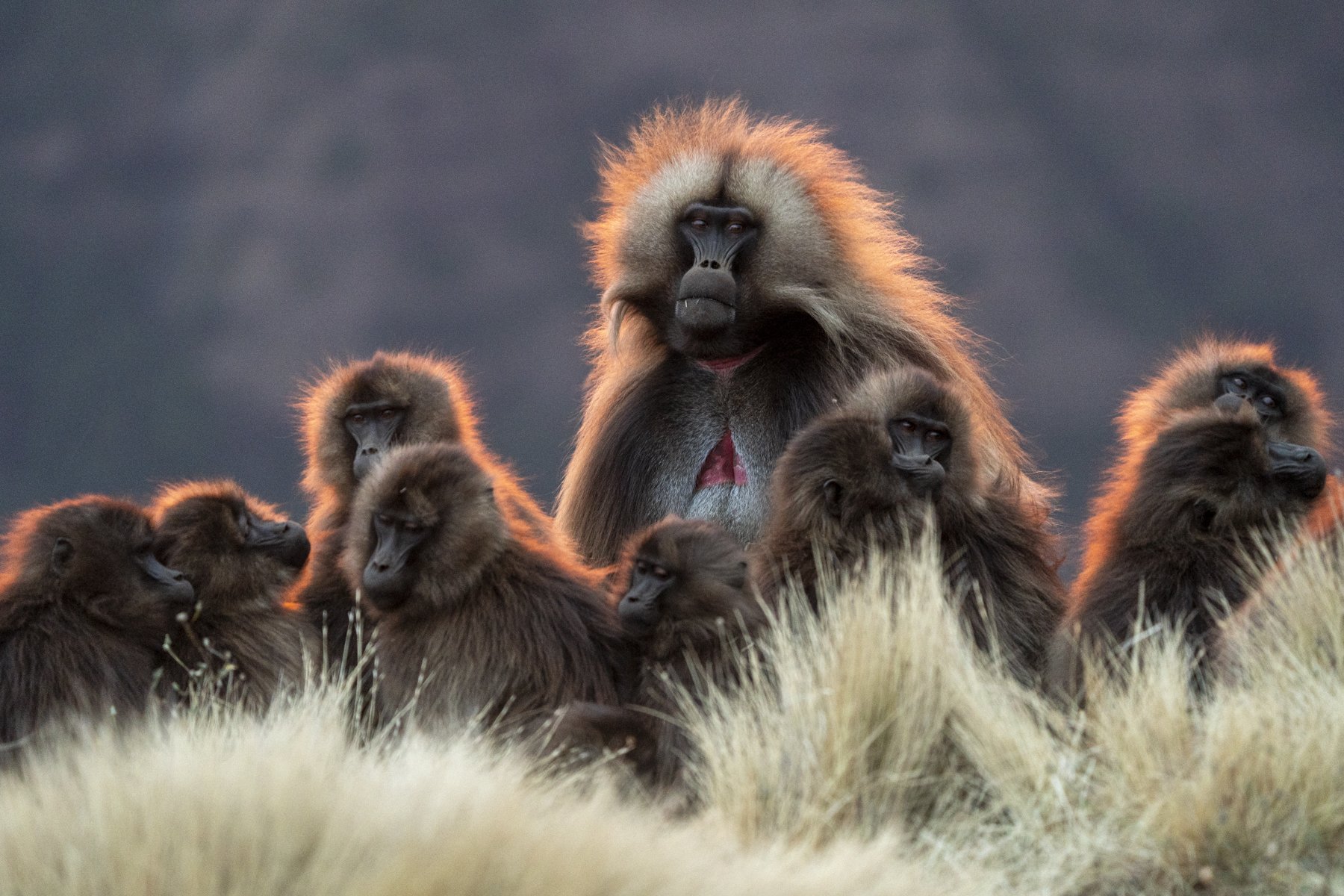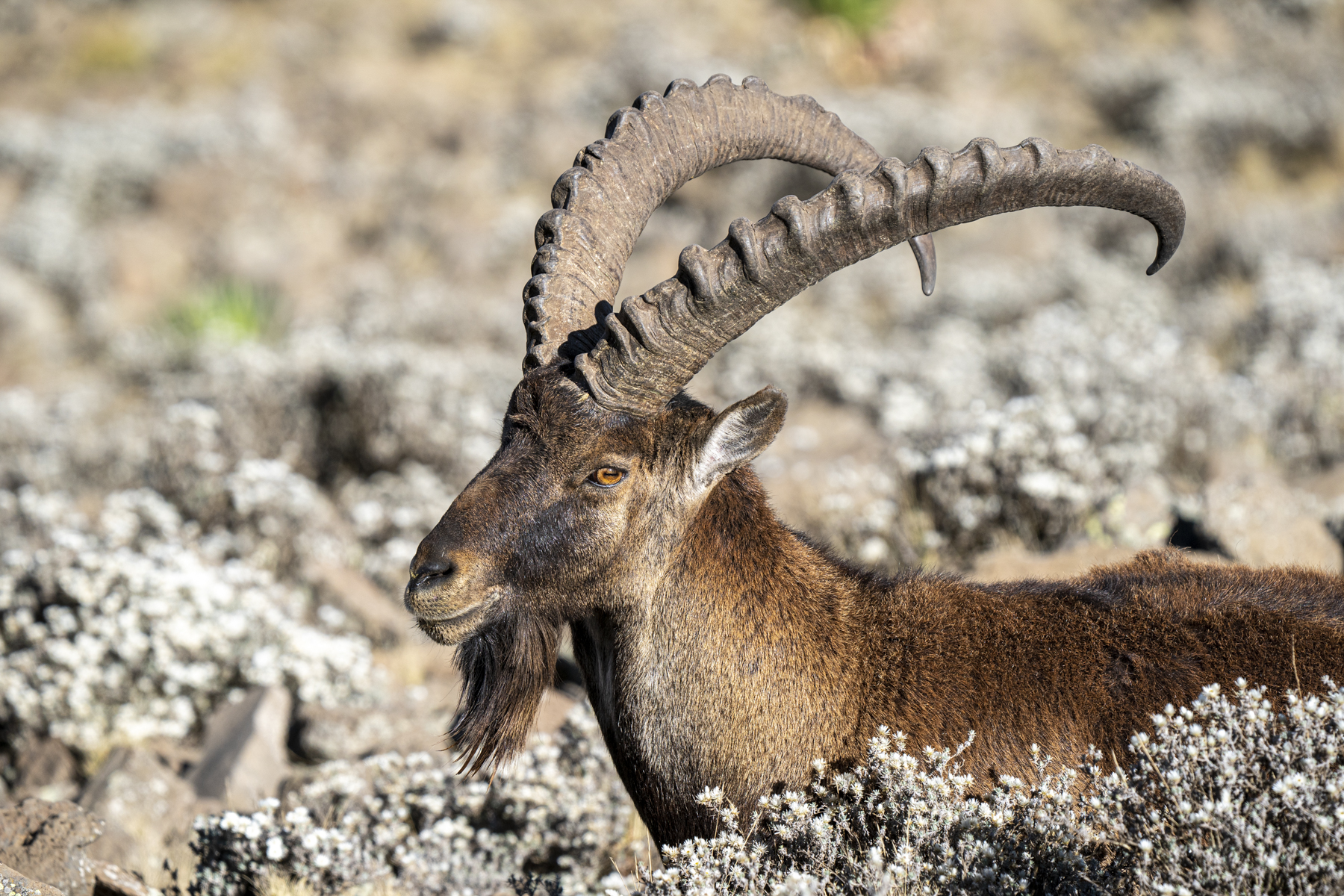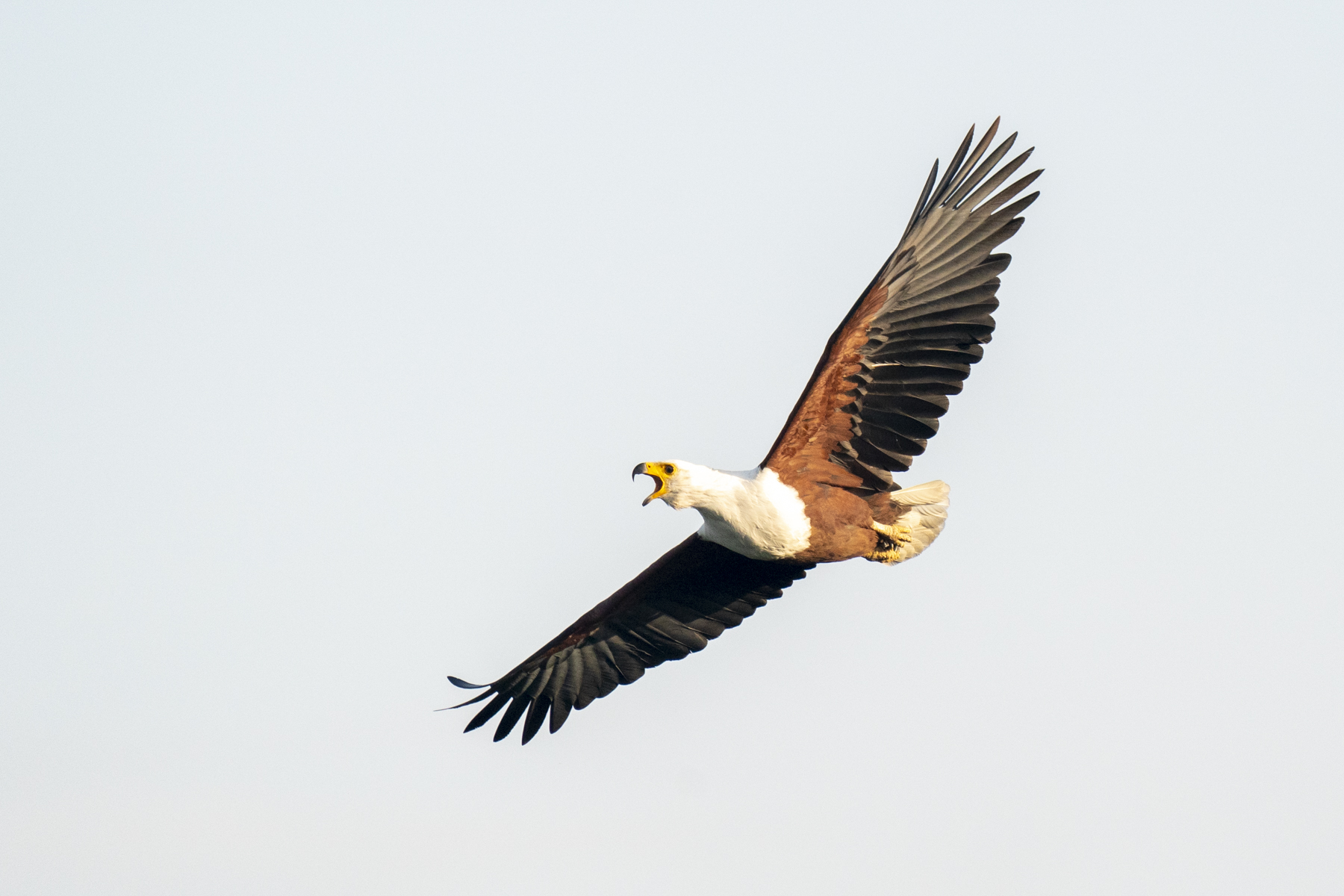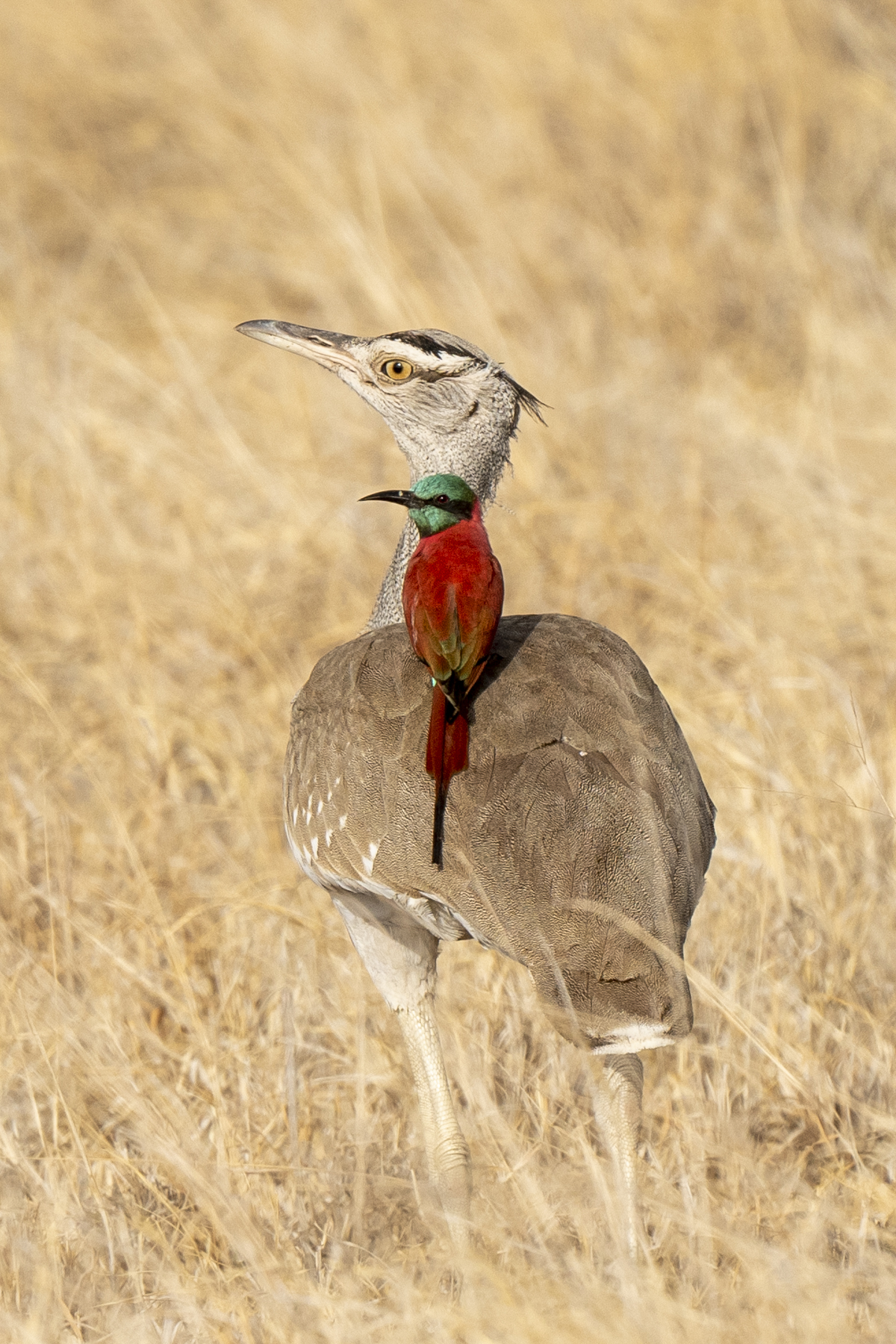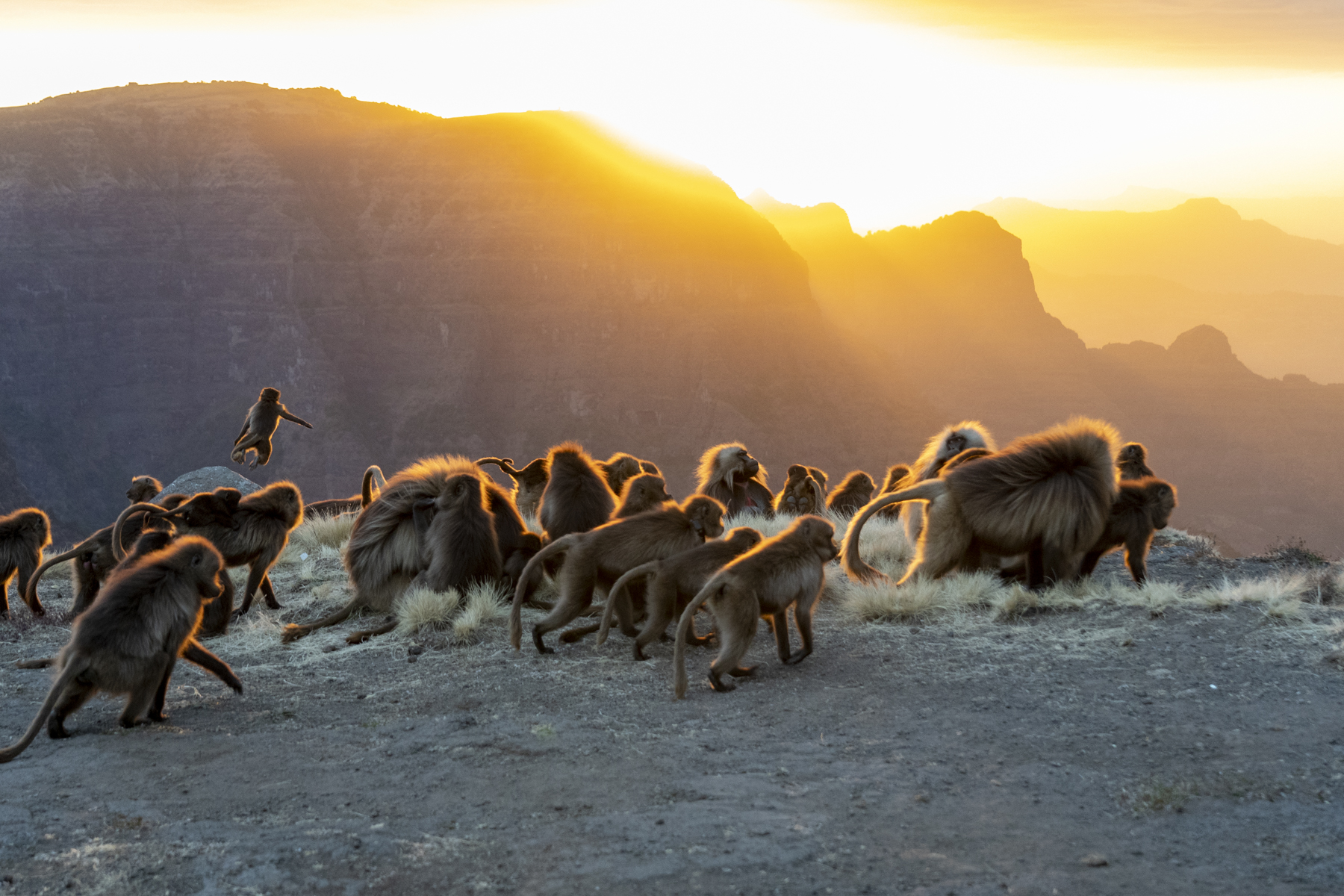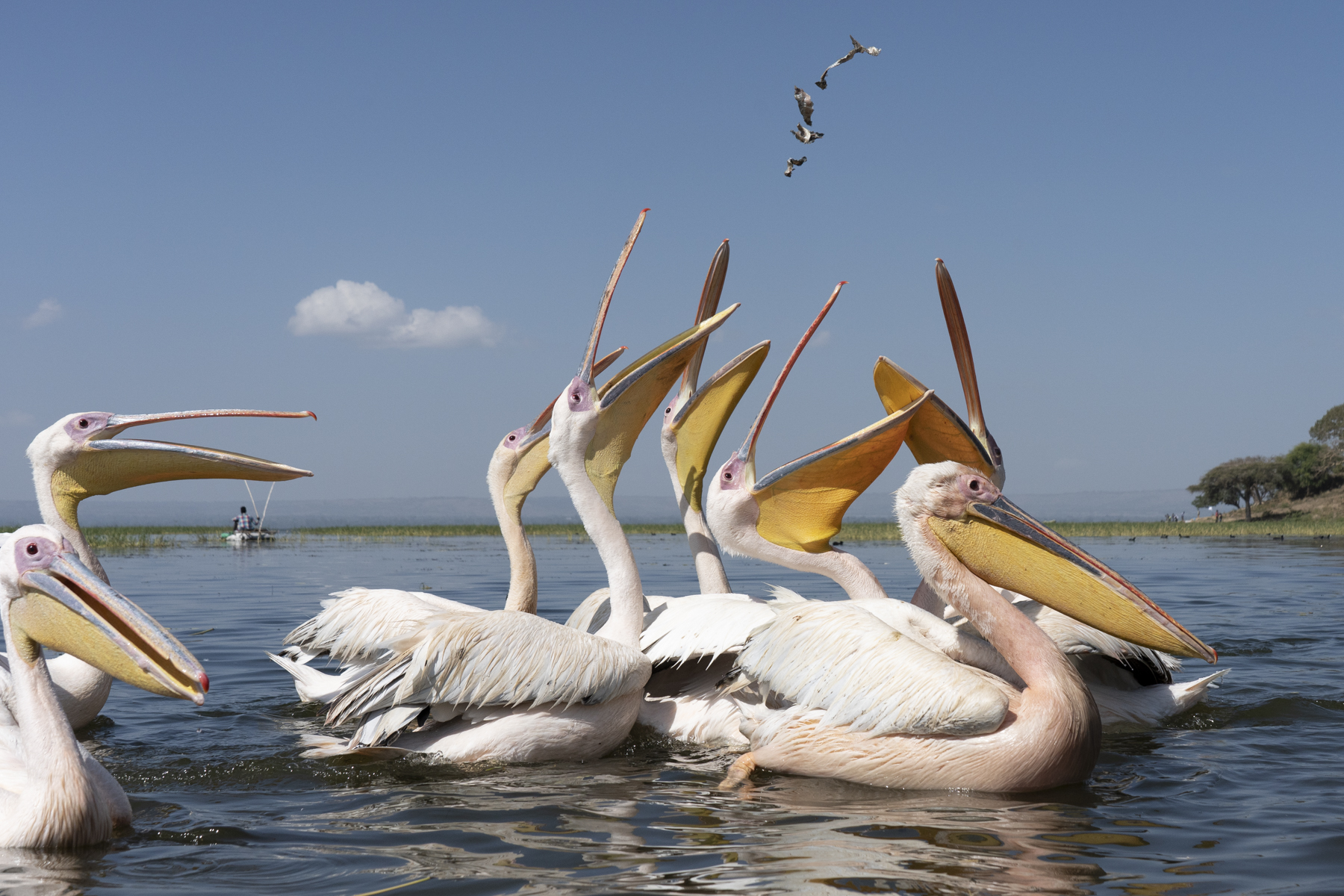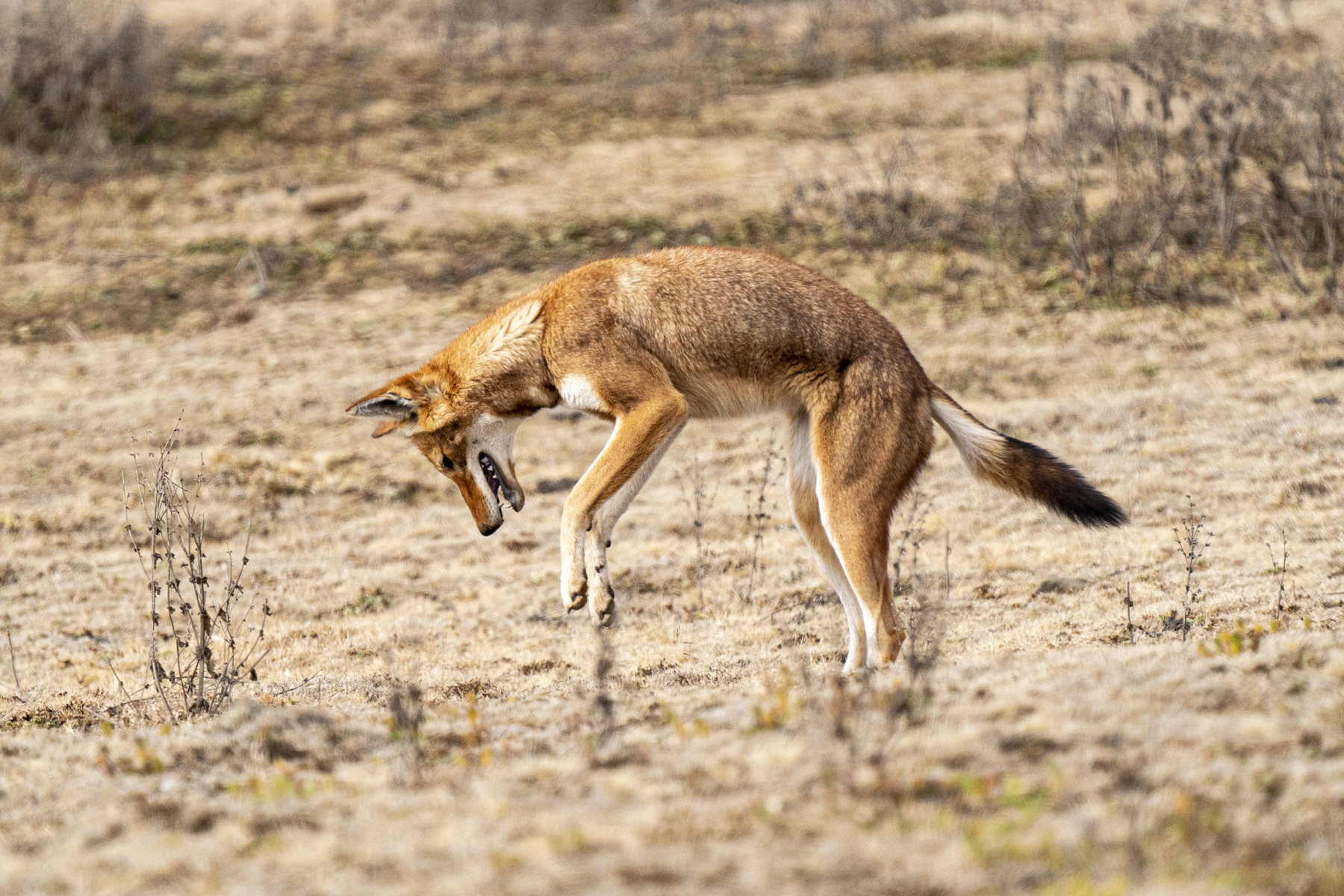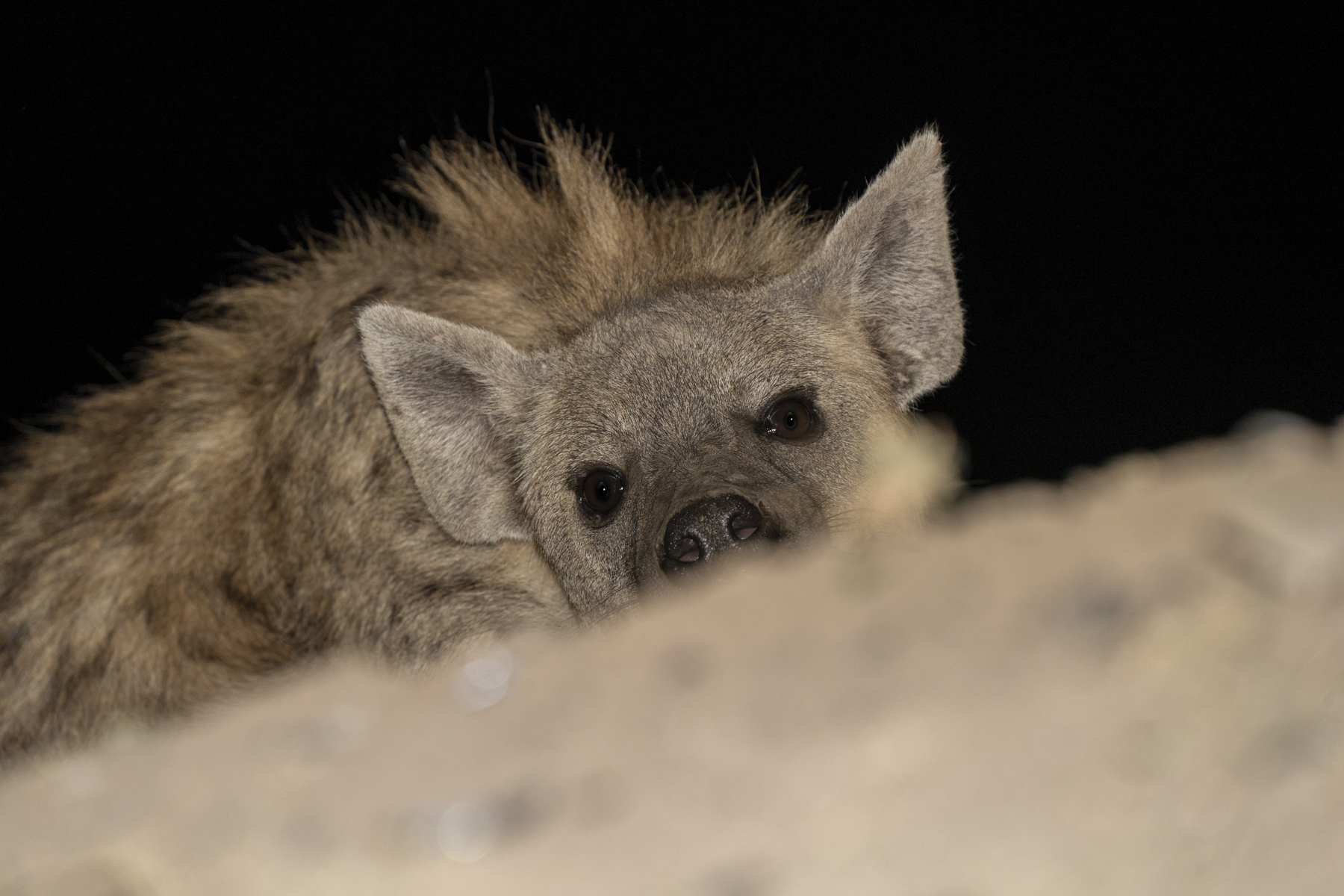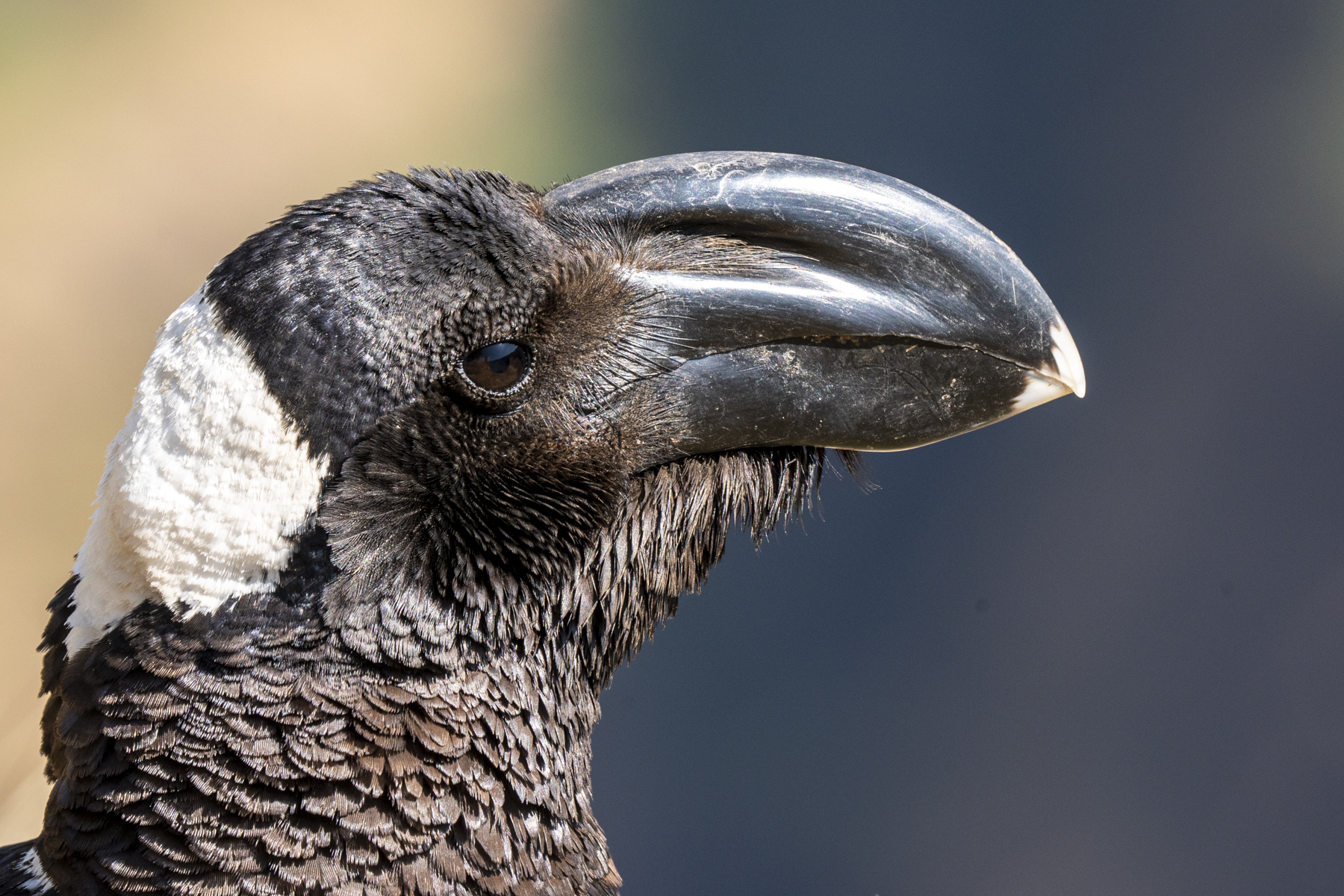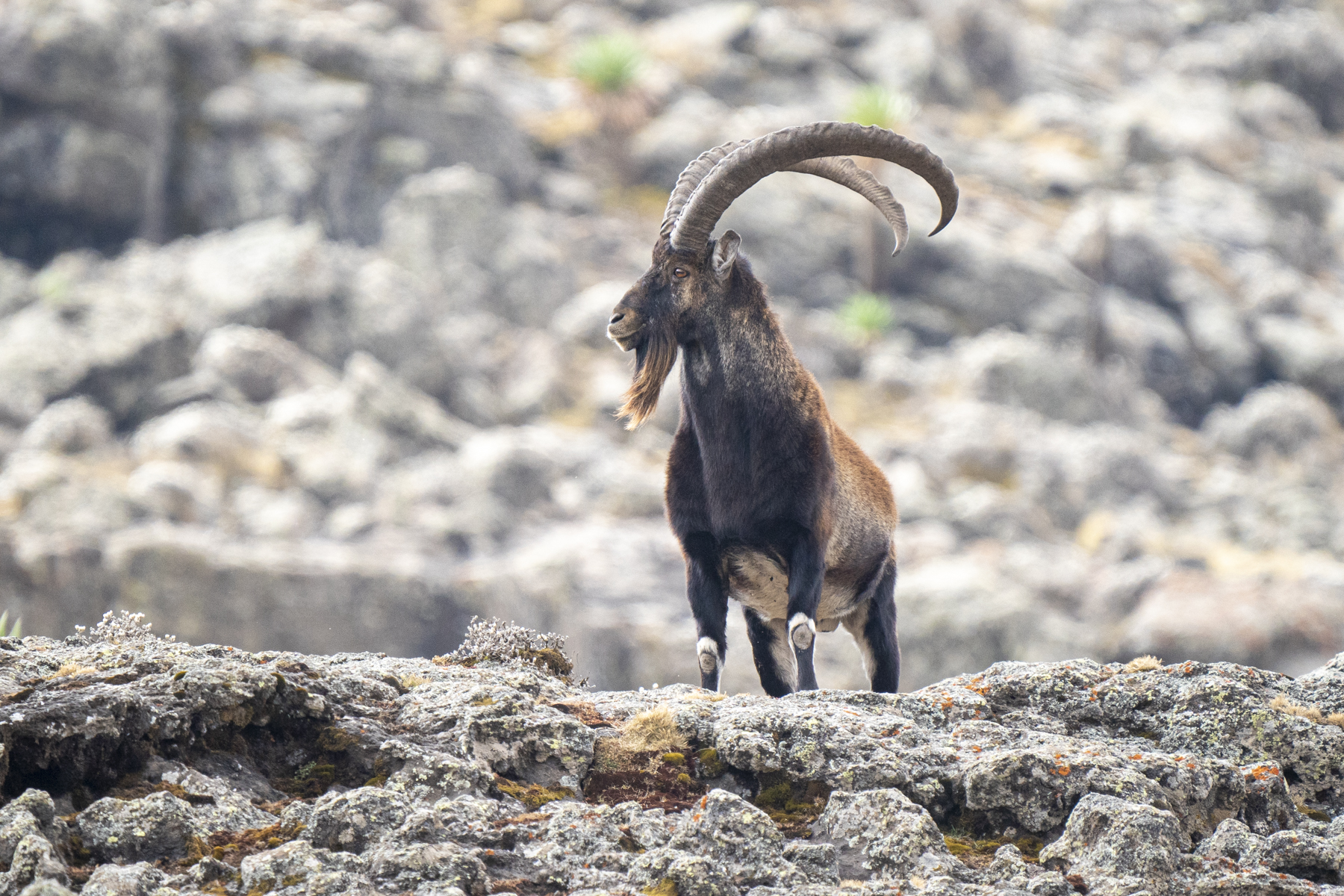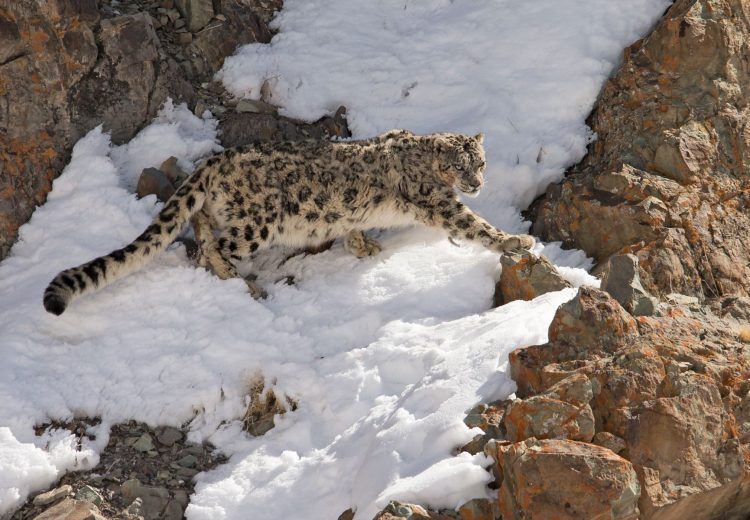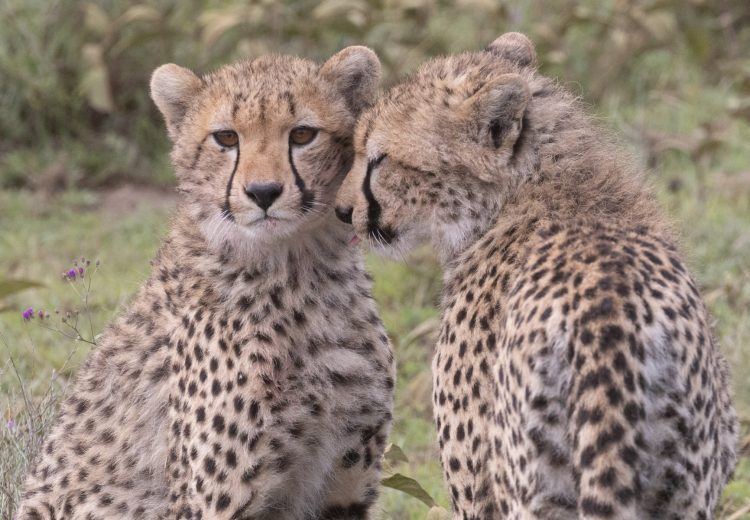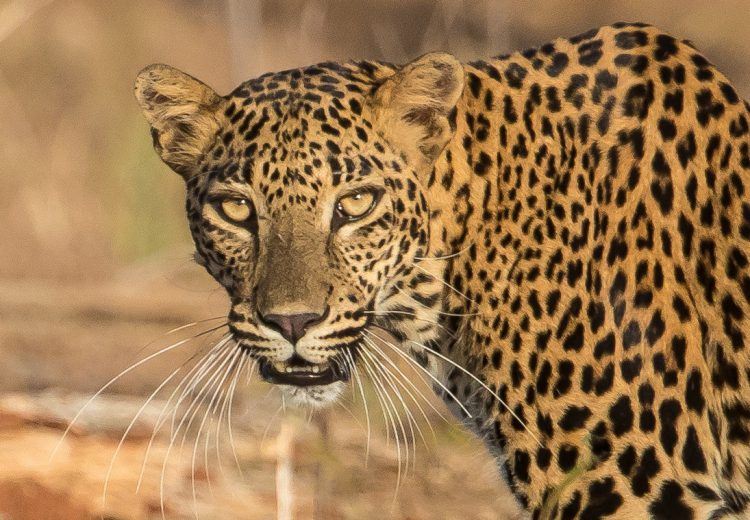Ethiopia
ETHIOPIA’S EXTRAORDINARY WILDLIFE: Geladas, Ethiopian Wolves, Ibexes, Hyenas, Birds & Much More


























































































































































































Thick-billed Ravens are very sociable birds (image by Mark Beaman)

Walia Ibex portrait (Image by Mark Beaman)

Male Walia Ibexes tussle at a cliff-edge (Image by Mark Beaman)

Male Walia Ibexes fight even outside the rutting period (Image by Mark Beaman)

It is not just the wildlife that is unusual in Simien. Giant Lobelias near Chenek (Image by Inger Vandyke)

The endemic Thick-billed Raven is an impressive bird of the Ethiopian highlands (image by Mark Beaman)

Gelada youngster at sunset (image by Mark Beaman)

A Fan-tailed Raven soaring over the Simien (Image by Mark Beaman)

I am the monarch of all I survey! A Gelada family at sunset (image by Mark Beaman)

Early morning in the Bale Mountains of Ethiopia (image by Mark Beaman)

Night is coming, we must head for the cliffs! Gelada motion blur, all but one... (image by Mark Beaman)

The attractive White-bellied Bustard (Image by Mark Beaman)

No you can't join our gang... (image by Mark Beaman)

A male Gelada Baboon surveys the steep escarpment of Ethiopia's Simien Mountains (Image by Mark Beaman)

The handsome Purple Roller (the purple area is only apparent when the wings are spread) (Image by Mark Beaman

Spotted Hyenas enjoying the feast put out for them by the 'Hyena Men' of Harar (image by Mark Beaman)

A Gelada male surveys the terrain ahead (image by Mark Beaman)

It must be Gelada love... (image by Mark Beaman)

The endemic Thick-billed Raven in the Simien Mountains (Image by Mark Beaman)

Gelada Baboon at sunset (Image by Mark Beaman)

An immature Bearded Vulture or Lammergeier (Image by Mark Beaman)

Backlit Gelada portrait (Image by Mark Beaman)

The endangered Wahlia Ibex, endemic to Ethiopia's Simien Mountains (image by Mark Beaman)

Buff-crested Bustards prefer thick cover (Image by Mark Beaman)

A young Afar girl in the Bilen area of eastern Ethiopia (Image by Inger Vandyke)

Marabou Stork portrait (Image by Mark Beaman)

Ethiopian (or Simien) Wolf yawning (Image by Mark Beaman)

Abyssinian Ground Hornbills are huge birds and seem oblivious to the midday heat (Image by Mark Beaman)

Abbas, the most famous 'Hyena Man' of Harar, with friend (image by Mark Beaman)

Gelada mother and baby (image by Mark Beaman)

Look at those beds! So much better than a cold cliff, and no Leopards to worry about either... (image by Mark Beaman)

The endemic Black-winged Lovebird (image by Mark Beaman)

This particular Augur Buzzard is an intermediate morph (Image by Mark Beaman)

Giant Lobelia flowering spikes are like huge punctuation marks on the Sanetti Plateau, Bale (Image by Mark Beaman)

The endangered and fast-vanishing Arabian Bustard (image by Mark Beaman)

Blue-winged Geese in the Bale Mountains (image by Mark Beaman)

This Star-spotted Nightjar really does look like a 'creature of the night' (Image by Mark Beaman)

Fortune favours the bold! Why wait? A Marabou leaps and gets its fish (image by Mark Beaman)

I'm sure I can find another flea... (image by Mark Beaman)

Ethiopian Wolf pack members greet each other (Image by Mark Beaman)

African Harrier-Hawk portrait (Image by Mark Beaman)

Chestnut-bellied Sandgrouse, a bird of arid landscapes in Ethiopia (Image by Mark Beaman)

The evocative cry of the African Fish Eagle is one of the charismatic sounds of Africa (image by Mark Beaman)

Male Gelada Baboon, Simien, Ethiopia (Image by Mark Beaman)

It is not often you turn round and a Common Warthog is right behind you! Except that is at Dinsho, Ethiopia (Image by Mark Beaman)

The Simien Mountains just after sunset (Image by Mark Beaman)

That hurt! Gelada Baboons in Ethiopia's Simien (Image by Mark Beaman)

An Ethiopian Wolf in rodent stalking mode (image by Mark Beaman)

An adult African Fish Eagle fights with a young bird over a fish (Image by Mark Beaman)

Common Warthog Portrait at Dinsho, Bale Mountains (Image by Mark Beaman)

Photographing a Northern Carmine Bee-eater riding on an Arabian Bustard's back is a 'Holy Grail' of African bird photography... (image by Mark Beaman)

Harar girl (image by Mark Beaman)

Guereza Colobus mother and baby at Awassa, Ethiopia (Image by Inger Vandyke)

Vast panoramas are what the wild Bale Mountains are all about (image by Mark Beaman)

An Ethiopian Wolf eating a Blick's Grass Rat (image by Mark Beaman)

Damn! That rat went in right here! (Image by Mark Beaman)

Spot-breasted Lapwing, one of the smartest of the Ethiopian Highlands' endemic birds (image by Mark Beaman)

Montane Francolin (Image by Mark Beaman)

Hamadryas or Sacred Baboons crossing the road (image by Mark Beaman)

A ray of sunlight illuminates a priest's crucifix at Lalibela, Ethiopia (Image by Inger Vandyke)

The fortress palaces of Gondar, Ethiopia (Image by Inger Vandyke)

Gelada close-up (image by Mark Beaman)

The lovely Blue-breasted Bee-eater (Image by Mark Beaman)

Harar woman (image by Mark Beaman)

Bohor Reedbuck (image by Mark Beaman)

The strange Wattled Ibis is a characteristic endemic bird of Ethiopia's highlands (Image by Mark Beamnan)

Wattled Ibises (image by Mark Beaman)

Geladas at sunset. There is still a chance to groom or play... (image by Mark Beaman)

Secretarybird (image by Mark Beaman)

Riding on mum's back is the way to go! (Image by Mark Beaman)

An Ethiopian Wolf eating a Blick's Grass Rat (image by Mark Beaman)

The 17th century castle of Emperor Fasilides at Gondar, one of the greatest buildings in subSaharan Africa at the time (image by Mark Beaman)

African Fish Eagle (Image by Mark Beaman)

A trio of Ethiopian Wolves in the Simien (Image by Mark Beaman)

Harar woman (image by Mark Beaman)

The critically endangered, endemic Ethiopian Wolf (image by Mark Beaman)

The 'enchanted' mossy Hagenia Forest of the Bale Mountains (Image by Mark Beaman)

Here comes breakfast! Great White Pelicans at Lake Awassa (image by Mark Beaman)

African Pygmy Goose (image by Mark Beaman)

A Gelada Baboon gives a 'lip-flip' threat display in the Simien Mountains of Ethiopia (Image by Inger Vandyke)

Every little counts when you are hoping to get the fish first. Marabou Storks at Awassa Fish Market (image by Mark Beaman)

Gelada mothers and babies (image by Mark Beaman)

Sometimes swinging on a thin branch ends badly... (Image by Mark Beaman)

The gorgeous Northern Carmine Bee-eater (Image by Mark Beaman)

The rather 'goofy' Giant Mole Rat (or Giant Root Rat), favourite food of the Ethiopian Wolf (image by Mark Beaman)

Spot-breasted Lapwing (image by Mark Beaman)

An Ethiopian Wolf pounces on its prey (image by Mark Beaman)

There is an awful lot of room in a pelicans bill-pouch... Great White Pelicans at Awassa (image by Mark Beaman)

The elaborate ceiling paintings of the Debre Berhan Selassie church in Gondar, Ethiopia (Image by Inger Vandyke)

The arid grasslands and thorny woodlands of the Awash region (Image by Mark Beaman)

A pair of beautiful Black Crowned Cranes (Image by Mark Beaman)

The tiny Malachite Kingfisher is like avian jewellery (image by Mark Beaman)

Gelada babies love to play (image by Mark Beaman)

A pair of handsome but endangered Wattled Cranes in Ethiopia (Image by Mark Beaman)

The handsome Beisa Oryx, a charismatic inhabitant of the arid lands of eastern Ethiopia (Image by Mark Beaman)

A young Gelada Baboon hangs from a thin tree branch (Image by Mark Beaman)

Portrait of an Ethiopian (or Simien) Wolf, Ethiopia's most iconic wildlife species (Image by Inger Vandyke)

Harar spice market (image by Mark Beaman)

Amhara farmers in the Simien (Image by Mark Beaman)

A pair of African Pygmy Geese at Awassa (Image by Mark Beaman)

African Black Ducks haunt clear rivers in the Bale Mountains (Image by Mark Beaman)

The rare and declining Arabian Bustard (Image by Mark Beaman)

A Northern Carmine Bee-eater rides an Arabian Bustard. The bee-eater gets the flushed insects and perhaps the bustard gets a sharp-eyed lookout (image by Mark Beaman)

The 'Kite Man' of Harrar, with friend (image by Mark Beaman)

Lanner Falcon (image by Mark Beaman)

An Ethiopian Wolf in the early morning light of the Sanetti Plateau in Ethiopia's Bale Mountains (Image by Mark Beaman)

Rosy-patched Bushshrikes duet at Awash National Park, Ethiopia (Image by Mark Beaman)

Great White Pelicans at Lake Ziway, Ethiopia (image by Mark Beaman)

Male and female Mountain Nyalas, endemic to the Ethiopian Highlands (image by Mark Beaman)

An Ethiopian Wolf wanders across the vast landscape of the Bale Mountains (image by Mark Beaman)

A pair of Augur Buzzards in the Bale Mountains (Image by Mark Beaman)

Dried chillies at Harar (image by Mark Beaman)

A Marabou Stork catches a fish at the Awassa fish market (Image by Mark Beaman)

Dancing Black Crowned Crane (Image by Mark Beaman)

A huge Wahlia Ibex male gets up after a rest (image by Mark Beaman)

Spotted Hyenas waiting for their opportunity (image by Mark Beaman)

The lovely Rosy-patched Bushshrike, a bird of arid habitats (image by Mark Beaman)

Geladas are very willing to try all kinds of foods (image by Mark Beaman)

The ancient city of Harar, Ethiopia (image by Mark Beaman)

Geladas gathering at the cliff-top at sunset, before climbing down to their sleeping places (image by Mark Beaman)

Simien shepherd boy (image by Mark Beaman)

Just part of the great castle complex at the ancient city of Gondar, Ethiopia (image by Mark Beaman)

Part of the fortress complex at Gondar, Ethiopia (Image by Mark Beaman)

A forest of camel legs (image by Mark Beaman)

The noisy White-bellied Go-away-bird (Image by Mark Beaman)

Mural at Debre Birhan Selassie church in Gondar (image by Mark Beaman)

Yellow-billed Kites over Harar, Ethiopia; the one at the lower left got the piece of meat! (image by Mark Beaman)

These Ethiopian Wolves have spotted potential prey further up the ridge (Image by Mark Beaman)

Gelada Baboons on the move (Image by Mark Beaman)

Eastern Yellow-billed Hornbill (Image by Mark Beaman)

A pair of Tawny Eagles (image by Mark Beaman)

I don't really care where he goes, as long as he scares up some insects... (image by Mark Beaman)

Gelada Baboons at the Simien escarpment, Ethiopia (Image by Mark Beaman)

Marabou Stork at Moonset (Image by Mark Beaman)

Augur Buzzard (image by Mark Beaman)

Harar lane (image by Mark Beaman)

Somali women at a camel market in eastern Ethiopia (image by Mark Beaman)

Sunset at Awash National Park (Image by Mark Beaman)

Ethiopian Klipspringers are cute little creatures (Image by Mark Beaman)

Spotted Hyena portrait (image by Mark Beaman)

A Bale shepherd crosses the high Afro-alpine moorland (Image by Mark Beaman)

The dominant Spotted Hyenas at Harar get first pick, while the subservient ones look on like waiting ghouls (image by Mark Beaman)

Malachite Kingfisher portrait (Image by Mark Beaman)

A camel market in eastern Ethiopia (image by Mark Beaman)

A patrolling Lanner Falcon soars overhead (Image by Mark Beaman)

An Ethiopian Wolf on patrol (Image by Mark Beaman)

Marabou Storks watch a thrown fish falling towards them (image by Mark Beaman)

A dark morph Augur Buzzard in the Bale Mountains (Image by Mark Beaman)

Guereza Colobus portrait (image by Mark Beaman)

Black Crake (image by Mark Beaman)

The sleek Black-backed Jackal (Image by Mark Beaman)

Spotted Hyenas sniff the ground, scenting their last feast from the Hyena Men of Harar (image by Mark Beaman)

The cryptic Lichtenstein's Sandgrouse is hard to spot until one is close (image by Mark Beaman)

An Ethiopian Wolf howls to its pack mates in the Bale Mountains (Image by Mark Beaman)

Mural at Debre Birhan Selassie church in Gondar (image by Mark Beaman)

A Gelada Baboon bares its formidable teeth (Image by Mark Beaman)

Gelada portrait (image by Mark Beaman)

The endemic Rouget's Rail in the Bale Mountains (Image by Mark Beaman)

A huge Kori Bustard strides across the arid plains (Image by Mark Beaman)

A lurking Spotted Hyena (image by Mark Beaman)

A Nile Crocodile basks on a rock in the Awash River (Image by Mark Beaman)

Mountain Nyalal male portrait (Image by Mark Beaman)

A pair of Blue-winged Geese, a species found only in the highlands of Ethiopia (Image by Mark Beaman)

Thick-billed Ravens often soar out over the precipitous Simien escarpment of Ethiopia (image by Mark Beaman)

A priest at the chapel of Asheten Maryam holds one of his treasured bibles (Image by Inger Vandyke)

Thick-billed Raven portrait (image by Mark Beaman)

A Beisa Oryx in the dry bush country south of the Danakil Depression (image by Mark Beaman)

Gondar passageways (image by Mark Beaman)

Male Geladas from behind can look a bit like some strange hairy plant (Image by Mark Beaman)

It's mine! Great White Pelicans at Lake Awassa (image by Mark Beaman)

Gelada portrait (image by Mark Beaman)

Grivet Monkey portrait (image by Mark Beaman)

The rare endemic Abyssinian Owl (Image by Mark Beaman)

Harar girl and her cat (image by Mark Beaman)

St George's rock church at Lalibela, Ethiopia at sunset (Image by Inger Vandyke)

Wahlia Ibex (image by Mark Beaman)

A large troupe of Gelada Baboons crosses the Simien grassland in northern Ethiopia. This is just a small part of a gathering of 400-500! (Image by Mark Beaman)

The smart Spot-breasted Lapwing is one of many Ethiopian endemic birds (Image by Mark Beaman)

Just one section of the spectacular Awash Falls (Image by Mark Beaman)

The dramatic landscape of Ethiopia's Simien Mountains, with giant Lobelias in the foreground (image by Mark Beaman)

Gelada Baboons are also known as 'Bleeding-heart' Baboons (Image by Mark Beaman)

A Guereza Colobus challenges a rival (image by Mark Beaman)

A Thick-billed Raven lets me know what it thinks of me (image by Mark Beaman)

Harar girl (image by Mark Beaman)
|
Thursday 15th January –
Saturday 31st January 2026 Leaders: Renato Granieri and a local guide |
17 Days | Group Size Limit 7 |
ETHIOPIA WILDLIFE PHOTOGRAPHY TOURS WITH WILD IMAGES
It is early morning on the high Sanetti Plateau in Ethiopia’s Bale Mountains. A mild ground frost has enhanced the already largely white vegetation that cloaks the spectacularly beautiful Afro-alpine moorlands, punctuated by rocky peaks and the tall, charismatic flowering spikes of Giant Lobelias. Suddenly there is movement. A tawny-coloured Ethiopian Wolf appears from behind a ridge and climbs up onto the summit rocks. It turns and howls, and soon after is joined by three others. The wolves greet each other and then trot right past us. As they disappear towards the rising sun a noisy party of Blue-winged Geese flights overhead and a Steppe Eagle, a winter visitor from Central Asia, glides towards us, on the lookout for the ubiquitous grass rats that are already warming themselves in the sun’s rays after the long, cold night. This then is ‘The Roof of Africa’, a truly unique place for the wildlife photographer.
There is no other place in sub-Saharan Africa where one can enjoy great wildlife and landscape photography and combine it with extraordinary cultural experiences. Ethiopia has all of this and more: the awesome landscapes and wildlife of the Bale and Simien Mountains, the spectacular cranes and other waterbirds of the Rift Valley Lakes and the palaces of Gondar, home of many of Ethiopia’s kings and emperors. Our special Ethiopia wildlife photography tours combine all of these wonders. See them for yourself!
Ethiopia’s highlands embrace the central part of the country like a necklace. The extraordinary Bale and Simien Mountains are home to some of Africa’s rarest wildlife, including the Walia Ibex, the Ethiopian (or Simien) Wolf and the gentle, vegetarian Gelada Baboon. It is a high altitude wonderland filled with wonderful wildlife, soaring cliffs, tussock grasses and stands of iconic Giant Lobelias. While we explore the dramatic scenery of these mountains, we will also be looking for Mountain Nyala, Menelik’s Bushbuck, Ethiopian Klipspringer, a variety of birds of prey (including the huge Bearded Vulture or Lammergeier), the iconic Thick-billed Raven, the lovely Spot-breasted Plover and the strange-looking Wattled Ibis, to mention just a few of our targets.
We will also have an opportunity to explore the lively town of Gondar, which served as the former capital of the Ethiopian empire. The city holds the mostly well-preserved remains of the Fasil Ghebbi, or Royal Enclosure, a walled stone fortress that is unique in sub-Saharan Africa, comprising a series of impressive palace-like buildings connected by grassy paths. Founded by Emperor Fasilides, the Fasilides ‘castle’ is the core building in this palace complex and it is accessed by an ancient stone staircase which leads you to a number of very grand rooms that open on to a balcony where the emperor used to address the Ethiopian people. We will also take a look at the fascinating Debre Berhan Selassie church, a classic example of Ethiopian Coptic church architecture and decoration.
The wildlife highlight of the Simien is undoubtedly the encounters we are going to have with huge troupes of Gelada Baboons. These large but gentle monkeys are vegetarian and here in Simien they are usually quite accustomed to, and tolerant of, close approach by humans. Even the big males will feed right next to you, provided you keep low and still. When we find a troupe, we will simply sit or lie among the feeding animals or walk with them as they move across a mountain meadow to graze on grasses and shrubs, while baby baboons play near our feet. As the sun goes lower in the sky we will search for them on the cliff edges as they return to their cliff nests to sleep after a day of grazing on the Simien plateau.
Before exploring the highlands, we begin our Ethiopian adventure by heading east to the historic city of Harar and the arid bushlands of Awash
Not many people know about the extraordinary ‘Hyena Men’ of Harar and the wild Spotted Hyenas that they feed every night, following the ancient custom of this remote holy city in eastern Ethiopia. Be prepared to be amazed. You will never have seen, or photographed, anything like it!
Although visiting a Hyena Man and his consorts is the ‘pièce de résistance’ of any visit to Harar, there are also the ‘Kite Men’ of Harar who feed the local Yellow-billed Kites and the opportunity to explore the best-preserved and most fascinating ancient walled city in Ethiopia. Harar’s narrow cobbled lanes, beautiful old houses, friendly, charismatic people and fascinating markets are reason enough to visit the city.
Awash is strikingly different from anything we will see later. Situated close to the huge Danakil Depression, its hot and arid landscapes are home to beautiful Beisa Oryx, Soemmering’s Gazelles, Northern Gerenuks, Sacred (or Hamadryas) Baboons, Lichtenstein’s Sandgrouse and Arabian and White-bellied Bustards. With just a bit of luck we will see and photograph a Northern Carmine Bee-eater riding along on an Arabian Bustard’s back! One of the ‘Holy Grail’ wildlife images from Northeast Africa.
What makes the Wild Images Ethiopia wildlife photography tour special?
Firstly, diversity: most tours restrict themselves to the two mountain massifs, the Bale and the Simien. These are indeed places with great opportunity and areas where Ethiopia’s most famous mammals are to one found, but you can greatly diversify your portfolio of wildlife images if you spend some time in other Ethiopian environments.
Secondly, our very extensive knowledge of Ethiopia really counts when it comes to the chosen locations of our accommodations.
For example, in the Bale Mountains, we base ourselves in Goba. The choices here, to most extents and purposes, are between a lodge in the Harenna Forest on the southern side of the massif and an hotel in Goba on the northeastern slope of the mountains. The lodge in the Harenna Forest is more comfortable (although the quality of the food is about the same, based on our experiences of both), so the choice might seem straightforward, but it is not. Location for photography is the key here. The best area for Ethiopian Wolf and indeed most other interesting mammals and birds, on the Sanetti Plateau is much nearer to Goba.
The Afro-alpine moorlands of the Bale and the Simien offer a major challenge to photographers owing to heat shimmer. The high altitude coupled with a vertical Equatorial sun at midday mean that there are only short early morning and evening windows for really good images on many days of the year. You can see plenty of wildlife between 0900-1600, but most images will be spoiled by shimmer. We think there is a huge advantage, in such a situation, to spend the unproductive middle hours of the day having a siesta or reviewing images, or both. Then getting out early and late is so much easier!
The other advantage of Goba, and it is a big one, is its proximity to the Dinsho area of Bale Mountains National Park (45 minutes, compared with around three hours from the Harenna). For the photographer, Dinsho is a must and we will certainly want to go there during our Bale explorations. Mountain Nyala and Menelik’s Bushbuck are much more confiding here, allowing a close approach, unlike on the high plateau, while the Common Warthogs are fearless and superb portraits are usually straightforward. In addition, Dinsho holds some charismatic owls and nightjars.
We have seen folk talking up the Harenna Forest by mentioning things like Lions, black morph Leopards, Giant Forest Hog, Wild Dogs, Bale Monkeys and the like, but the reality is that your chances of encountering, never mind photographing, any of these creatures in the area are exceedingly low, as we know from personal experience.
Then there is the Simien. It is absolutely key for photography to stay inside the park, where there is just one lodge, Simien Lodge. It is quite expensive, but well worth it, as we can be out early and come back late and not be restricted by the opening hours of the park gate. This means we will have the opportunity to photograph backlit Gelada Baboons, Walia Ibexes and raptors in the early morning light and the awesome Simien scenery at sunrise and sunset.
And finally, there is that little matter of the ‘Hyena Men’ of Harar. Something utterly unique.
Lalibela Option
If you would like to visit Lalibela and its famous, World Heritage Site rock churches before or after the tour, we can easily arrange this for you. You will be well looked after by a local guide. Please let us know if you are interested.
Accommodation
Accommodation during our Ethiopia wildlife photography tour will generally be in good or medium quality lodges and hotels (the latter in areas where nothing better is available). At Bilen, where we spend one night, the lodge is very simple, but all rooms have private bathrooms.
Road Transport
Transport will be by 4×4 Toyota Landcruisers or similar. There will only be a maximum of 3 participants in each vehicle, giving everyone plenty of space and their own window and their own door for a fast exit when photography demands it! (Many tours use small buses in Ethiopia, but we don’t think these appropriate for serious photographers.) Main roads in Ethiopia are rapidly improving (some are now really good) but roads in remote areas are much more variable and can be quite rough dirt roads.
Walking
Most of the walks during our Ethiopia wildlife photography tour are relatively easy and short.
Climate
The highlands of Ethiopia enjoy pleasant daytime temperatures of around 20°C (68°F), but at night the temperatures can drop much lower, especially in the Bale and the Simien (where ground frost is possible). At lower altitudes, temperatures are hot in the middle of the day.
Photographic Equipment
During our Ethiopia wildlife photography tours, the most used telephoto lens focal lengths with a full-frame DSLR or mirrorless are usually between 400-600 mm (sometimes even longer is useful). Focal lengths of 100-300 mm will, however, be necessary for some wildlife shots (notably when close to Geladas or hyenas).
Ethiopia has many magnificent panoramic views and a wide-angle in the 16-35mm range is ideal. You will also want to cover the range up to 70 mm or more.
All the focal lengths mentioned above relate to full-frame cameras. Please adjust as appropriate for crop sensor and micro four-thirds cameras.
You can also get wonderful results throughout this Ethiopia wildlife photography tour, with many subjects, with a high quality ‘bridge’ camera with an 18-20x or higher optical zoom and a wide-angle setting which is equivalent to 24mm.
A tripod or a monopod can be helpful if you use a heavy telephoto. Almost all of our photography will be on foot, so using either is straightforward on this tour.
If you have questions about what equipment you ought to bring, please contact us.
Photographic Highlights
- Visit the amazing ‘Hyena Men’ of Harar, and experience Spotted Hyenas up close and personal!
- Photograph the ancient walled city of Harar.
- Explore the arid bushlands of the Awash region, home to Beisa Oryx, Arabian Bustard and many other interesting creatures
- A good chance for photographs of a Carmine Bee-eater riding on a n Arabian Bustard’s back!
- Gentle Guereza Colobus monkeys, naughty Grivet monkeys, grotesque Marabou Storks and Great White Pelicans in the Awassa region.
- Repeated encounters with the world’s rarest canid, the handsome Ethiopian Wolf on the ‘Roof of Africa’ in the wild Bale Mountains.
- Handsome Mountain Nyalas, tame Warthogs and unusual owls.
- Blue-winged Geese, Bearded Vultures, francolins and Rouget’s Rails.
- Extraordinary Afro-alpine vegetation and ‘enchanted’ moss forests.
- Communing with huge troupes of one of Africa’s most charismatic apes, the Gelada.
- The incredible wild landscapes of the stunning Simien Mountains.
- Searching for the rare Walia Ibex, Menelik’s Bushbuck and Ethiopian Klipspringer, plus encounters with Thick-billed Ravens and birds of prey in the most beautiful region of Ethiopia’s highlands.
- Explore the ancient fortress palaces of Gondar, the most impressive in sub-Saharan Africa.
OUTLINE ITINERARY
- Day 1: Morning tour start at Addis Ababa airport. Flight to Dire Dawa. Transfer to Harar. First session with the Hyena Man.
- Day 2: Exploring Harar. Second session with the Hyena Man.
- Day 3: Transfer to Bilen in the Awash region.
- Day 4: Exploring the Bilen area.
- Day 5: Bilen area, then transfer to Lake Ziway.
- Day 6: Lake Langano, then transfer via Senkelle reserve to Awassa.
- Day 7: Lake Awassa, then transfer to Goba. Explore Dinsho area in Bale Mountains.
- Days 8-10: Exploring the Bale Mountains.
- Day 11: Bale Mountains, then return to Awassa.
- Day 12: Lake Awassa, then return to Addis Ababa. Evening flight to Gondar.
- Day 13: Visit Gondar's palaces, then transfer to Simien Mountains.
- Days 14-15: Exploring the Simien Mountains.
- Day 16: Simien Mountains, then return to Gondar.
- Day 17: Morning flight to Addis Ababa and tour end.
To see a larger map, click on the square-like ‘enlarge’ icon in the upper right of the map box.
To see (or hide) the ‘map legend’, click on the icon with an arrow in the upper left of the map box.
To change to a satellite view, which is great for seeing the physical terrain (and for seeing really fine details by repetitive use of the + button), click on the square ‘map view’ icon in the lower left corner of the ‘map legend’.
PRICE INFORMATION
Wild Images Inclusions: Our tour prices include surface transportation, accommodations, meals and entrance fees.
Our tour prices also include all tips for local guides, drivers and accommodation/restaurant staff.
We also include these flights:
Addis Ababa-Dire Dawa
Addis Ababa-Gondar-Addis Ababa
Deposit: 20% of the total tour price. Our office will let you know what deposit amount is due, in order to confirm your booking, following receipt of your online booking form.
TO BOOK THIS TOUR: Click here (you will need the tour dates)
2026: provisional £6450, $8490, €7720, AUD12650. Addis Ababa/Addis Ababa.
Single Supplement: 2026: £750, $990, €900, AUD1470.
Kindly note that the tour price includes the full cost of the three internal flights provided you are flying into Addis Ababa with Ethiopian Airlines, which entitles you to special fares
You will need to provide us with your booking reference if you are not booking your Ethiopian Airlines flights through us. In the event you are not flying into Addis Ababa with Ethiopian Airlines, a supplement of US $200 will apply.
If you are travelling alone, the single supplement will not apply if you are willing to share a room and there is a room-mate of the same sex available.
This tour is priced in US Dollars. Amounts shown in other currencies are indicative.
Air Travel To & From The Tour: Our in-house IATA ticket agency will be pleased to arrange your air travel on request, or you may arrange this yourself if you prefer.
ETHIOPIA WILDLIFE PHOTOGRAPHY TOUR: DETAILED ITINERARY
Day 1
The tour starts this morning at Addis Ababa airport.
You can choose to arrive by air this morning with Ethiopian Airlines or by another carrier, or you can elect to arrive the previous day and get some rest by having an extra hotel night. If you arrive early enough you can explore the city if you wish. There are plenty of interesting things to see, including Emperor Menelik’s tomb, the cathedral, the national museum and the huge and fascinating Mercato open-air market.
From Addis Ababa we will take a flight eastwards to the city of Dire Dawa and from there drive up into the Chercher Mountains to the city of Harar, where we will spend two nights. We will arrive in time to enjoy a first exploration of the city and then have our first session this evening with the ‘Hyena Men’.
Harar is an ancient city, known simply as Gey (‘the city’) to its inhabitants. The date of its foundation is unknown, but it was already important by the 13th century and later became the capital of the Adal Sultanate and its successor state, the Emirate of Harar, in the 16th century.
Quite how the Hararis started feeding Spotted Hyenas is lost in legend, but it does seem they were tolerated and indeed encouraged in the city as nocturnal scavengers as far back as the 16th century, as low doorways were built at that time in the city walls to accommodate them! The various legends about feeding include stories that they were publicly fed porridge so that they could act as impromptu soothsayers through their style of eating it, or that they were fed to discourage them from eating livestock or even people during droughts, or even that Muslim saints communicated with their clan leaders and persuaded them not to do harm in return for handouts.
In any event, it seems the feeding had long since stopped before it was revived in the 1950s or 1960s, perhaps through nothing more than chance encounters with hyenas and the inclination to see if they would accept food. Since then it has become a nightly event at Harar, with two senior ‘Hyena Men’, Mulugeta Wolde-Mariam and Yusuf Mume Saleh, and their assistants, operating at two different sites outside the walls.
Spotted Hyenas have a fearsome reputation, only partly because of their manner and appearance, but also because of their ruthless hunting style in the wild, so seeing them come close to humans and take meat from small sticks held in what seems a tiny hand, next to their huge muzzles, or even a human mouth, seems pretty awesome to the rest of us! Not only do the hyenas take food but they ‘lovingly’ rest their huge paws on the Hyena Man’s back or head and generally behave like large friendly dogs!
As well as being able to take photographs, at close range, of the Hyena Men and their nightly ‘guests’ from the surrounding forests (where the hyenas live a perfectly normal life for 23 hours a day), we will also be able to get great shots of them lurking in the background, resting before they feed or prowling in sinister fashion. If you are so inclined you can get down low for better angles (so far they have never eaten anyone!) and if you are really brave you will get the chance to feed them yourself.
Needless to say, the whole experience is utterly unforgettable and a wildlife photography encounter that is completely unique.
Day 2
This morning there will be time to explore the ancient medina of Harar and its surrounding fortifications, known as the Jugal (or Jugol). The walled old city dates back to around the 16th century and is a fascinating warren of small alleyways, markets, mosques and ancient buildings. Harar is widely considered to be the 4th holiest city in Islam, after Mecca, Medina and Jerusalem, but today it is famed for its tolerance of other faiths and Harar beer, brewed naturally enough by Christians, is widely available. It is said that there are 99 mosques in Harar, chiming with the 99 known names of Allah, but in reality, there are ‘only’ 86. Harar is a wonderful place for photography, especially if you get out early while the light is at its best.
We will also enjoy a photographic session with one of the ‘Kite Men’ of Harar. Feeding the Yellow-billed Kites is a recent development, not some ancient tradition, but it is fun to watch and photograph the kites swooping down and often squabbling in mid-air over small pieces of meat from a ‘Kite Man’s’ hands.
At dusk, we will of course return for a second session outside the town walls with our ‘Hyena Man’, something none of us will ever forget!
Day 3
After some final photography at Harar, we will drive down from the Chercher Mountains and into the arid Awash Valley region. Our destination is a remote lodge in the Bilen area, where we will stay for two nights.
This interesting area is inhabited by Afar people who were formerly nomadic herders but now live a more settled existence, although they continue to use the long, rounded thatched dwellings that they used while moving from one area of pasture to another.
Late this afternoon we will start our exploration of the Bilen area.
Day 4
The dry plains of this part of the Awash River region hold the near-endemic Sacred (or Hamadryas) Baboon, as well as Soemmering’s Gazelle, Beisa Oryx, the long-necked Northern Gerenuk and the delightful little Salt’s Dikdik. Interestingly, the Golden Jackals of Africa have recently been split off as a distinct species, African Golden Wolf, on the basis that their genetics place them closer to the wolves and coyotes. There is a good chance of photographing this newly ‘promoted’ wolf in this area. With a bit of luck, we will also encounter Northern Lesser Kudu.
The open grasslands and acacia bushlands here are a stronghold of the stately, but declining Arabian Bustard. With persistence and just a bit of luck we will come across an Arabian Bustard with one or more Northern Carmine Bee-eaters riding on its back! This truly extraordinary photographic highlight is dependent on how many bee-eaters are around. They use the bustards as convenient ‘lookout posts’ from which to hawk large flying insects. Somewhat surprisingly, the bustards seem to tolerate these colourful ‘hitch-hikers’, perhaps because they provide warning of approaching predators.
Birdlife is varied and among the most appealing photographic targets are the huge Somali Ostrich, Lappet-faced Vulture, Tawny Eagle, Pallid and Montagu’s Harriers, Pygmy and Lanner Falcons, Buff-crested, Hartlaub’s and White-bellied Bustards, Black-headed Lapwing, Chestnut-bellied Sandgrouse, Blue-naped Mousebird, the superb Abyssinian Roller, Northern Red-billed and Eastern Yellow-billed Hornbills, Somali Fiscal and the lovely Rosy-patched Bushshrike (pairs often duet together).
Day 5
We will spend the early morning in the Bilen area if need be and then head westwards towards the Great Rift Valley (a vast and dramatic geological feature that runs all the way from southeastern Turkey to southern Africa!).
After a time we will arrive at Lake Ziway, where we will overnight at a comfortable hotel right at the lakeside. Lake Ziway is a great place for photography, and of course of a kind we will not enjoy while in the Bale or Simien. We can walk out directly onto either of two promontories that start at our hotel and enjoy the spectacle of numerous waterbirds, most of which are highly approachable. (An important aspect of Ethiopia, and one which makes it so good for wildlife photography, is that birds and indeed most creatures are not harmed by local people.)
Large flocks of Great White Pelicans are a feature here and we are likely to get surprisingly close to these huge and impressive birds. Among the many other stars are the jewel-like Malachite Kingfisher, the long-toed African Jacana, the huge Goliath Heron, the strange Hamerkop, the noisy African Fish Eagle and the superb Saddle-billed Stork. Additional species we are likely to shoot include White-faced and Fulvous Whistling Ducks, Spur-winged and Egyptian Geese, Hottentot Teal, Pink-backed Pelican, Reed Cormorant, African Darter, African Sacred and Glossy Ibises, Yellow-billed Stork, Black-winged Stilt, Spur-winged Lapwing, Gull-billed, Whiskered and White-winged Terns, Red-eyed Dove and Pied Kingfisher (try and take them hovering). Rather macabre Marabou Storks nest in the trees around the hotel.
Day 6
We will set off early and drive the short distance to the northern end of Lake Langano. The grounds of a rather run-down hotel usually hold impressive Greyish Eagle-Owls and many cryptically-coloured Slender-tailed Nightjars, and while looking for these nightbirds we are likely to find and photograph the endemic Black-winged Lovebird and Red-throated Wryneck, as well as Namaqua Dove, White-bellied Go-away-bird, the weird-looking Speckled Mousebird, Little Bee-eater, Eurasian Hoopoe, Black-billed Wood Hoopoe, and colourful Greater Blue-eared, Rüppell’s and Superb Starlings.
From Langano we continue south to the town of Shashamane for lunch and then, during the late afternoon, we will explore the rarely-visited Senkelle Wildlife Sanctuary, last stronghold of the endemic Swayne’s Hartebeest. These impressive chestnut-coloured antelopes are still common here and the grasslands also feature White-bellied Bustard and the gorgeous Northern Carmine Bee-eater. Eventually we will arrive at Awassa, a town situated beside the lake of the same name, where we will overnight.
Day 7
Our hotel is situated right at the lakeshore and the grounds and surroundings are a great place for early morning photography. Beautiful, black and white Guereza Colobus monkeys with long bushy tails frequent the area and, since the hotel staff give them a few tidbits, are very confiding, allowing for great shots. Mothers with tiny infants are especially appreciated. Playful Grivet Monkeys also occur here.
Along the adjacent lakeshore, the more photogenic birds include the delightful little African Pygmy Goose, African Fish Eagle, Squacco Heron, the perky little Black Crake and Woodland Kingfisher. African Spotted Creeper, a very uncommon and patchily-distributed bird, also occurs here, but we cannot honestly claim it will be at the top of most folk’s targets!
After the day starts to heat up, our thoughts will turn to cool, high mountains, so we will head up into the Bale mountains for a four nights stay at Goba. This afternoon we will enjoy our first photography session in these beautiful mountains.
Days 8-10
We will be spending much of our time exploring the wild and spectacular Afro-alpine moorlands of the high Sanetti Plateau, one of the best places in the Bale Mountains for finding Ethiopian Wolf. The handsome Ethiopian (or Simien) Wolf has had a difficult time in recent decades, suffering from distemper epidemics introduced by domestic dogs (incursions of which have become more common as the region’s human population has increased). This is now the world’s rarest canid, although, happily, a recent campaign to vaccinate local dogs, organized by the Ethiopian Wolf Conservation Programme has brought about a welcome rebound in the population.
The wolves tend to go around singly or in small groups and during the course of our visit we should have repeated encounters with them, watching them patrol their territories, greet each other, relax or hunt rodents and other prey. While we should be able to see them catch rodents, you can consider yourself lucky if you witness a close-up ‘kill’ and likewise, although most packs will have pups at this season, getting great photo opportunities with cubs must be considered a real bonus.
The number of rodents here is quite extraordinary, and of course they provide a bonanza for predators. It is estimated that their density is such that combined weight of rodents per square kilometre (or about 0.4 square mile) is no less than 4 tons! The great majority on the moorlands (and the main prey species of the Ethiopian Wolf) consist of three Ethiopian endemics: Blick’s Grass Rat, Black-clawed Brush-furred Rat and the extraordinary, endangered Giant Mole Rat. The latter, a huge blind rodent with very goofy teeth, is constantly enlarging its burrows to reach new food supplies and we will have some fun trying to sneak up on them to take some photos. They have good hearing and also detect vibrations, so in spite of their blindness, a close approach is not easy!
While the handsome Mountain Nyala is regularly seen on the moorlands, the landscape is open and approaching them closely on foot is often unsuccessful. For far better opportunities we will head for the Bale Mountains National Park headquarters at Dinsho. Here, some of the Nyalas have become unafraid of humans and will allow a close approach, as will Menelik’s Bushbucks and especially the ultra-tame Common Warthogs, which one can get to within a couple of metres!
Dinsho is also a good place for bird photography, often including African Wood Owl, the huge Verreaux’s Eagle-Owl and the uncommon endemic Abyssinian Owl. (Cape Eagle-Owls also occur here, but are usually too distant for good images.)
Not far away is a good area for photographing Bohor Reedbucks and Olive Baboons.
Day 11
After a final photography session in the Bale Mountains, we will return to Awassa for an overnight stay.
Day 12
Not far out of Awassa town is the fish market, where enterprising fisherfolk have found out they can get a small tip from visiting photographers for throwing fish to the Marabou Storks and Great White Pelicans. We will spend plenty of time here to enjoy the spectacle.
Afterwards, we will head northwards to Addis Ababa airport, from where we take an early evening flight to Gondar, a city situated not far from Lake Tana in northern Ethiopia. We will stay overnight at the comfortable Goha Hotel, perched on a high hill with a spectacular view over the city.
Day 13
Before we leave Gondar, we will visit the Imperial Palaces and the Debre Berhan Selassie church.
Officially founded by Emperor Fasiledes in 1636 as a third permanent capital city of Ethiopia, Gondar is notable for its most impressive Imperial Palaces/Castles and churches. The dramatic, castle-style palaces built over a period of more than 150 years reveals the influence of Axumite, Indian and even Portuguese and Moorish architecture in Ethiopia.
The beautiful church of Debre Berhan Selassie, famous for the colourful mural paintings on the ceiling, which according to legend was saved by a swarm of bees when the Mahdist soldiers from Sudan sacked and burned down the city in the 1880s, reflects the religious art of the Gondarine period.
Afterwards, we will head for the World Heritage Site of Simien Mountains National Park. The drive between Gondar and Debark is very scenic, particularly at Kosoye some 32km (20 miles) north of Gondar, where Queen Elizabeth II of England camped in 1965 while driving between Gondar and Axum.
At Debark we will collect a park scout and permits at the park headquarters and then continue our drive to Simien Lodge, where we stay for three nights. This afternoon, after lunch at our dramatically-situated lodge (which claims to be the highest lodge in Africa, and they are surely right!) we will start our photographic exploration of the extraordinary Simien Mountains.
Days 14-15
Created by massive erosion, the Simien Mountains is one of the most spectacular landscapes in the world: jagged mountain peaks with many summits over 4,000m (roughly 13,000ft), deep valleys and 1,500m sheer precipices. The park is home to the highest peak in the country, Ras Dashen, which is 4543 metres (14,906ft) above sea level.
The Simien Mountains is also the refuge of the endangered endemic Ethiopian (or Simien) Wolf, the extraordinary Gelada Baboon and the endangered Walia Ibex, a wild goat unique to Ethiopia. It is also home to endemic birds such as the Thick-billed Raven and Wattled Ibis.
In addition to its wonderful scenery and wildlife, the park is also famous for its Afromontane forest, Hypericum woodland, Afromontane grassland and Afro-alpine moorland dominated by Giant Lobelias, Red Hot Pokers, tree heaths, giant St. John’s Wort and African Roses. As you can see, no Ethiopia wildlife photography tour can afford to miss out the extraordinary Simien!
We will explore the scenic Simien escarpment in order to find the endemic Gelada Baboons. Nicknamed ‘bleeding heart baboon’ and ‘lion-monkey’ for reasons that will soon be obvious to all, Gelada Baboons are peculiar to Ethiopia and Eritrea, still being numerous in the Simien Mountains. Geladas are mainly vegetarian, living on herbs, grasses and roots, but they also eat insects including and locusts. Geladas live along the rim and steep slopes of the escarpment, which is their refuge when danger threatens.
On one or more days, after an early breakfast, we will leave the lodge for Chenek guard post, taking a picnic lunch. The scenery around Chenek is even more awesome than further west near our lodge, with huge peaks, crags and cliffs in the foreground and distant granite domes below the Simien escarpment. Here we can look for the endemic Walia Ibex. As well as photographic opportunities with the ibex, we will also be hoping for an encounter with the handsome Ethiopian (or Simien) Wolf, a declining species that still occurs regularly around Chenek.
We also have a high chance of spotting wildlife such as Ethiopian Klipspringer, Menelik’s Bushbuck, Bush Duiker and raptors including the huge Steppe Eagle, Tawny Eagle and the magnificent Bearded Vulture or Lammergeier.
Day 16
After spending much of the day in the Simien we will return to Gondar for an overnight stay.
Day 17
Our Ethiopia wildlife photography tour concludes with a morning flight to Addis Ababa.
Ethiopia’s Extraordinary Wildlife Tour Report 2020
by Mark Beaman
We started off our Ethiopia’s Extraordinary Wildlife 2020 expedition at Addis Ababa, but soon enough we were riding in our 4×4 Landcruisers out of this huge, ever-growing city and heading downslope into Africa’s Great Rift Valley, a huge crack in the earth’s surface that, amazingly, extends from southern Turkey all the way to southern Africa! […]
View Report
Other Wild Images Tours featuring signature mammals
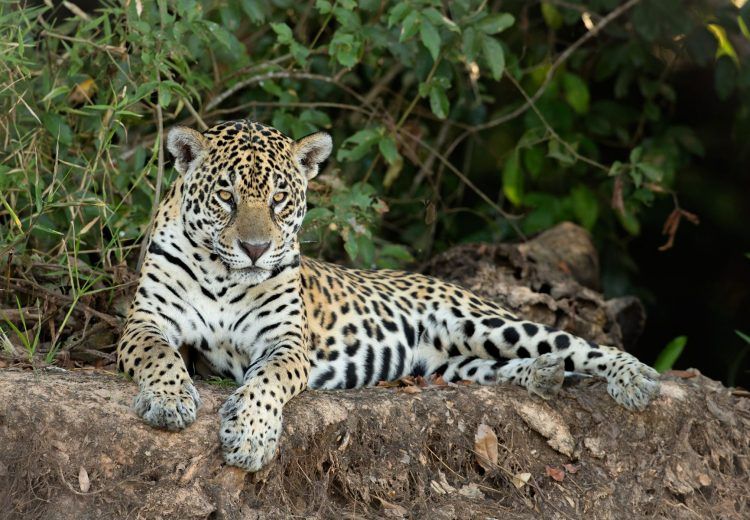
South America (including Galapagos)
August-September 2024
BRAZIL’S PANTANAL: JAGUARS AND SO MUCH MORE – South America’s best wildlife photography destination
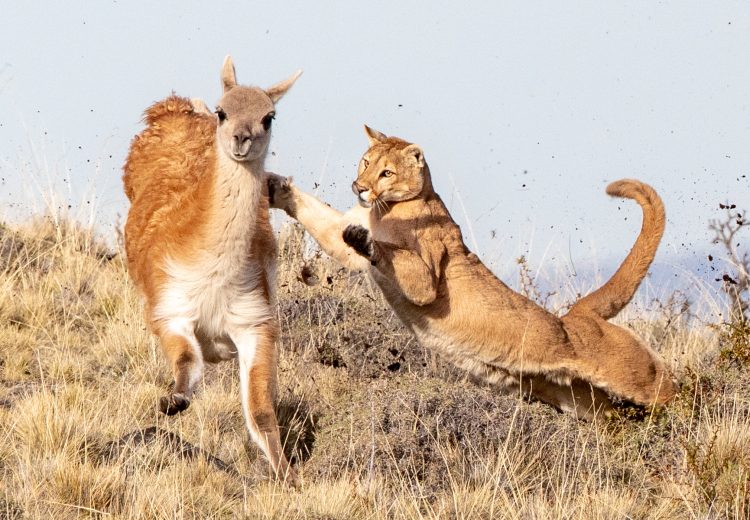
South America (including Galapagos)
August-September 2024
CHILE: WALKING WITH PUMAS – An Extraordinary Photographic Adventure at Torres del Paine
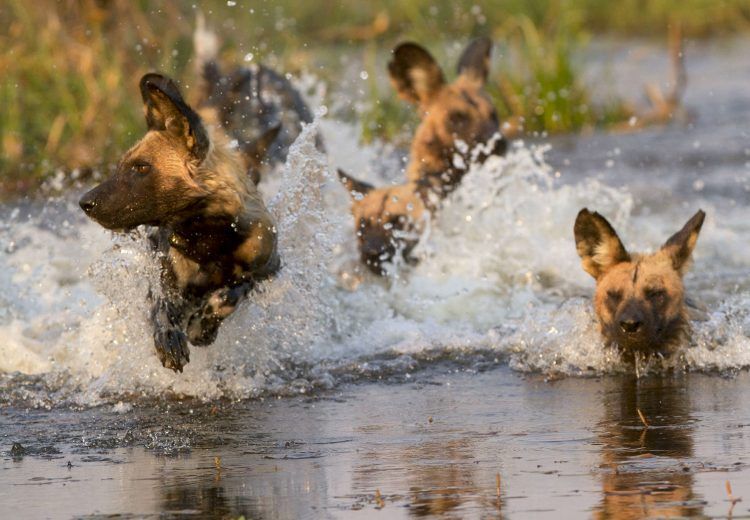
Botswana & The Okavango
November 2024
BOTSWANA: WILDLIFE SPECTACULAR – The photographic wonders of the Okavango and Chobe
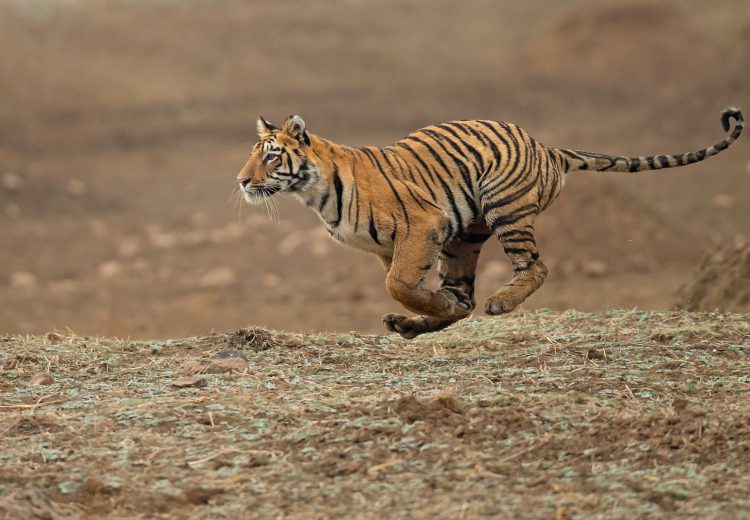
India
March-April 2025









